“Adaptation is defined as the process where a species or an organism gradually becomes better acclimated to its environment.”
Adaption refers to the behavioral or physical attributes of an animal that helps them survive better in its ecosystem. Animal adaptation can be in the way they look (camouflage) to escape from their predators. Different animals have developed different adaptations to survive in their habitat.
Table of Contents
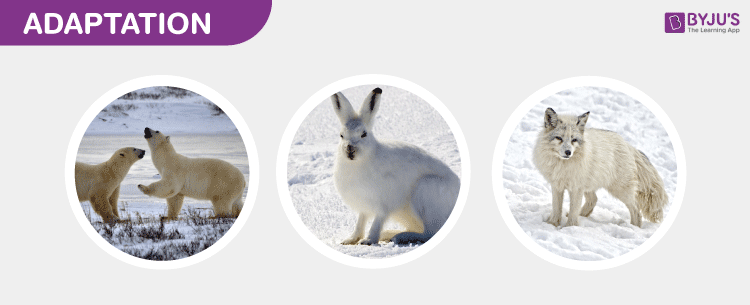
Animals living in the extreme cold have dense fur and fat for heat insulation
Adaptation Meaning
The meaning of adaptation implies how a species changes its body and behaviour to better suit its natural environment. There are an estimated 8.7 million species currently living on earth. They are found across a wide and diverse natural environment, ranging from frozen and desolate Arctics to the sweltering sands of the Sahara.
The natural environment is an ever-changing feature of planet earth. The process of adaptation ensures that the species which adapts the most, survive.
Read on to explore plant and animal adaptations across the wide ranges of landscapes.

Examples of Adaptation
In Humans:
Long hours of exposure to the sun results in a tan. As the exposure to heat and UV rays increases, the melanocytes present in the skin ramp up the production of melanin.
This pigment helps to absorb the heat and protects the nucleus, thus protecting the DNA from mutation due to UV radiation. Hence, the process of tanning represents how our body adapts to the heat and UV radiation from the sun.
Example 2: In high-altitude environments, the human body signals an increase in the production of red blood cells. This is done to compensate for the relatively low-oxygen content in the air.
But this is not an instantaneous process, hence, people who are not acclimatized to the high altitude environment might feel a shortness of breath.
In Animals:
Animals living in extremely cold environments have thick fur and fat around their body to provide insulation. Pregnant polar bears bulk up on fat before the winter. This is an adaptation that helps them survive the harsh winter where food is very scarce.
Sometimes, adaption is often mistaken for evolution, though both are very different processes. Evolution brings about drastic changes that occur in the genetic level, whereas adaptation is a short-term process where the changes that occur are usually reversible.
But adaptation does lead to evolution. Following is an example illustrating how evolution is different from adaptation.
Example of Evolution
Giraffe
Giraffes are the tallest land mammals today, but they weren’t so tall a few million years ago. During the Miocene Epoch, nearly 25 million years ago, the earliest giraffe ancestor was the size of a modern red deer. It did not have a long neck, nor long legs like its modern-day relatives.
However, the competition for food with other herbivores was rather stiff. However, the leaves in the taller shrubs and trees was an untapped niche. But only the animals with longer necks were able to graze on the foliage higher up in the trees.
So, traits that contained the genes for longer necks were passed down over many generations. Eventually, this adaptation led to the gradual evolution of animals with longer necks. 25 million years later, we have the tallest land animal on earth today – the giraffes.
Also Read: Bergmann’s rule
Types of Adaptations
Types of adaptations in animals and plants are categorized according to their function and the response observed. These include:
Structural Adaptations
These are special attributes that involve some parts of an organism’s body, such as skin, colour and shape. These adaptations help the organisms to survive in their natural habitat. Examples include the blubber of a whale, the beak of a woodpecker, baleen of a humpback whale.
Physiological Adaptations
These are mechanisms present in an organism that allow it to perform certain biochemical reactions to survive in its natural habitat. Example: A snake’s ability to produce venom, mammal’s ability to maintain constant body temperature. Even the ability of our body to produce hydrochloric acid to digest food is considered as a physiological adaptation.
Behavioural Adaptations
These are ways a particular organism behaves to survive in its natural habitat. Migration of animals and birds are considered as a behavioural adaptation. Hibernation and aestivation are also behavioural adaptations.
Animal Adaptations
The most significant animal adaptations entirely depend on the type of habitats they are found in. The earth has several natural environments that are spread across large geographic areas. In the broadest sense, this area, where life exists, is called the biosphere.
Animal Adaptations In Deserts
The desert has extreme temperature fluctuations – soaring heat during the day and sub-zero temperatures at night. It also has very limited water bodies and rain is rather scarce. But there are many animals that are well-adapted to life in the desert.
Camels, jackrabbits, foxes, snakes, insects are some of the predominant xerocoles or desert animals. However, these animals in the desert have to face many major challenges, from water conversation to avoiding excess heat.
Various Desert Animal Adaptations:
Conservation of water through reduced sweating
Camels are able to withstand ambient temperatures of 44℃ without sweating. Cold-blooded animals entirely lack sweat glands as they rely on the external environment to regulate body temperature.
Adaption to nocturnal life
The average daytime temperatures in the desert often exceed more than 38°C. Nocturnal lifestyle helps to cut down the loss of water, especially in desert biomes. It also enhances osmoregulation. Some animals become active during twilight hours, i.e., during dawn and dusk. Such animals are called crepuscular animals.
Specialized Mode of Excretion
Birds and reptiles in the desert retain water as their metabolic wastes are excreted in the form of an insoluble white compound called uric acid. When compared to mammals, the metabolic wastes are excreted through urea, a considerably more soluble compound.
Other Sources of Water
Natural sources of water, such as lakes and river are almost non-existent or are seasonal. So, animals derive water from desert plants such as cactus. Some insects also tap fluids such as saps and nectars from various parts of the plants.
Specialized Appendages
Animals like the jackrabbit have very large ears that have a network of blood vessels. When these animals rest in the shade, their enormous ears dissipate the excess heat from their bodies.
Check this video to know more about Adaptation in plants and animals in the Desert:
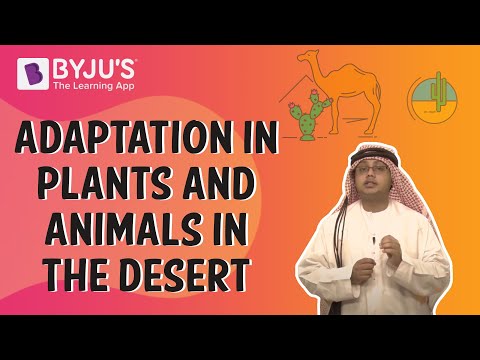
Animal Adaptations In Grassland
Grasslands are areas where the dominant vegetation is grasses. Grasslands are found throughout the world except for Antarctica. The largest grasslands are found in East Africa. One of the characteristic features of grasslands is its wide-open spaces.
This means the average speed of animals is much higher – for predators and prey. Therefore, it is no surprise that two of the fastest land animals in the world are found in grasslands – the cheetah (top speed: 113 km) and the pronghorn antelope (top speed: 98 km)
Few of the Grassland Animals Adaptations
Specialized Digestive systems
Animals that live in the grasslands like the bison have specialized teeth and digestive systems that help in breaking down the tough grass.
Camouflage
Predators that ambush their prey have skin colours that closely resemble their environment. This enables them to blend in and sneak up to their prey.
Feeding Habits
Grasslands near the equator have relatively high ambient temperatures. Hence, some herbivores such as antelopes graze at night, as this is when the vegetation has the most water content. The same can be said for some nocturnal predators too, as they can prevent unnecessary water loss.
Also Read: Mammalia – Diversity in Living Organisms
Animal Adaptations In Tropical Rainforests
Tropical rainforests are generally hot and humid as it is located near the equator. The average temperature is higher than 15 °C even in the winter and crosses 40 °C in summer. Rainfall is also plenty, with average annual precipitation between 60 inches to 160 inches.
There are also extremes, with some places receiving over 400 inches annually. Tropical rainforests are found in India, Brazil, Central America. The largest tropical rainforests are found in the Amazon River Basin in South America.
Significant Tropical Rainforest Animal Adaptations
Camouflage:
This is an important aspect in almost all biomes, including the animals that live in the tropical rainforests. Primarily, animals need camouflage for either predation or to avoid becoming the prey.
The Green-Eyed Tree frog has textured flaps of skin that is designed to resemble the tree barks on which it resides. This adaptation helps the frog to blend in and not become prey.
Mimicry:
Sometimes, having a good camouflage is not enough. So, some animals resort to mimicry, where they change their physical appearance to mimic other animals, which are usually poisonous or venomous.
This reduces the chances of becoming prey for other predators. The Margin-winged stick insect (Ctenomorpha marginipennis) does mimicry so well that it resembles a piece of twig or a dried-up stalk.
Animal Adaptations In Polar Regions
The polar regions represent extreme weather conditions and inhospitable environments. Polar regions include the north and south poles, countries such as Sweden, Iceland, Norway. These regions are usually covered in snow almost the entire year.
Average winter temperatures reach as low as -37 °C. Furthermore, the sun does not set for over 6 months and for the next 6 months, it does not rise at the poles.
Prominent Polar Region Animal Adaptations
Dense Fur:
This is an important adaptation as it protects the organisms from the extreme cold. Animals such as polar bears have fur even covering the soles of their feet. This prevents them from slipping on the ice.
Sometimes, the white colour of the fur helps to camouflage the animal against the background of the snow. This helps in predation or not becoming prey.
Blubber:
In some sea mammals such as whales and seals, a thick layer of fat covers the entire body, except for the fins and flippers. This layer provides insulation from the bitter cold and also aids in buoyancy.
They can also fall back on this fat as a food resource when there is no food available in the environment or during periods of inactivity (such as hibernation). Moreover, research has found that blubber is much more effective at retaining heat than fur.

Adaptations of Plants
Earth is known to have around 3,00,000 species of plants. Like animals, plant life is also dependent on various fundamental necessities for their survival. Light, water, air, soil, nutrients and suitable climatic conditions are necessary for growth.
But every habitat does not provide the required necessities. Therefore, plants have evolved certain physiological, behavioural and structural modifications to thrive in such environments.
Adaptations of Plants In Deserts
Deserts are too dry and hot to imagine life in them. Despite these arid conditions, few plants have adapted to thrive here.
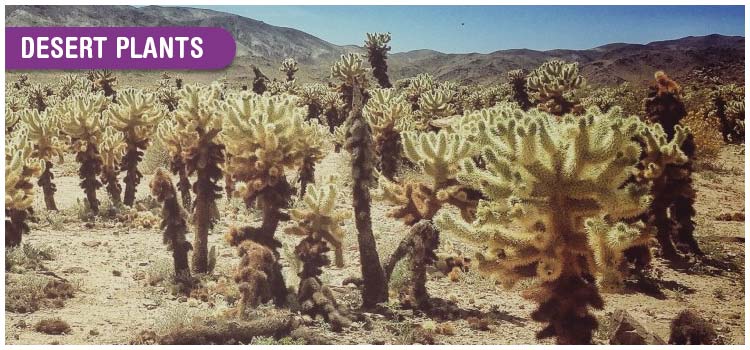
The spines on cacti help prevent excessive loss of water
-
Succulents are such plants which can store water in their modified stems and leaves
-
The spines on cacti also help prevent excess water loss
-
Some plants have long, deep roots which can absorb water from the ground
-
Other plants grow short to save energy
-
Another form of adaptation is dormancy, few seeds remain dormant until they get the water needed for growth
Adaptations of Plants In Tropical Rainforests
Tropical forests are usually packed with big and tall trees. These tall trees often provide stiff competition for small shrubs and herbs. Tall trees block the sunlight from reaching the ground. They are also known to absorb the nutrients from the soil.

Some plants climb the branches of taller trees to get sunlight
-
In such conditions, ground level plants start flowering during the spring season. This is because, during autumn, other trees shed their leaves, which means more sunlight reaches the forest floor.
-
Other species of ground-level plants are adapted to carry out photosynthesis in low light.
Adaptation in Aquatic Plants
Plants which live in water ecosystem like lakes, rivers, ponds, bogs etc. face many problems. The most common are low oxygen content, low light intensity, lack of soil, and nutrients.
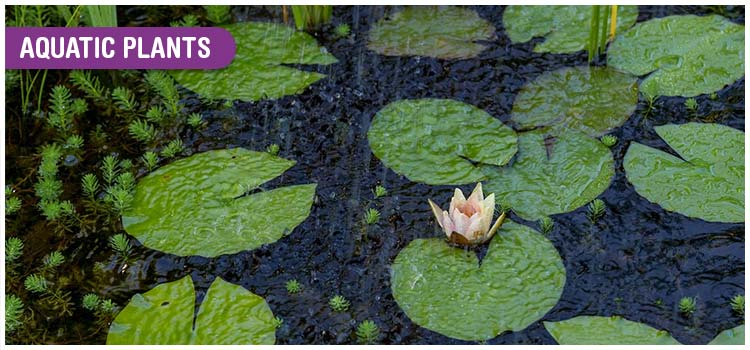
Aquatic plants have their roots underwater, but the upper half partially emerges from the water to enable photosynthesis
-
Some of these issues are resolved by floating in water streams. Aquatic plants develop in a way such that their roots are in the water, but the upper half partially emerges from the surface of the water for efficient photosynthesis.
-
Food, nutrients, and air are absorbed through modified stems and roots.
Adaptations of Plants In Polar Regions
Polar regions include one of the coldest regions on earth. And the vegetation found here is quite sparse. Sedges, dwarf shrubs, grasses and certain mosses and lichens are some plant species found in these terrains. The special features of these plants include short stature (not more than 12 inches), hairy parts, darker colour etc.

Only plants with shallow roots grow in the tundra because the deep layers of permanently frozen ice prevent the roots from breaking through the permafrost
Sometimes, trees hold on to dead leaves for insulation. However, larger plants such as trees as uncommon as the roots cannot penetrate deeply because of the permafrost.
Adaptations of Plants against Herbivory
Herbivory is the consumption of plant matter by any organism. Since plants are the primary producers in an ecosystem, nearly all consumers depend on them for sustenance. Therefore, to prevent herbivory, plants developed thorns, spines and chemicals.

Plants employ spines, thorns or toxins to deter herbivores
Thorns are the most common form of deterrent. Other plants might use chemicals to leave an unpleasant taste in the mouths of the herbivores. But some of these chemicals are very toxic and might result in the death if consumed.
Habitat
A biome is a place where a plant or animal lives. Biome also is known as a habitat, a part of an ecosystem. The climate, plants, and animals are the identities of a habitat. Habitats are classified into two domains: Terrestrial/ Land habitat and Aquatic/Water habitat.
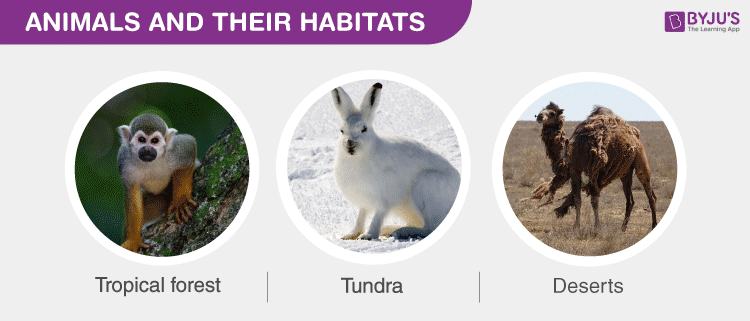
A habitat is the natural environment of an organism
Land habitat includes forests, grasslands, deserts, coastal and mountain regions. The aquatic ecosystem includes freshwater habitats (lakes, ponds, rivers and streams, wetlands, swamp, etc) and marine habitats (oceans, intertidal zone, reefs, seabed, etc.).
Living organisms sustaining on different habitats depend on that habitat for their food, shelter, reproduction and all other life activities.

To know more about adaptation meaning, animal adaptations and adaptations in plants or other related topics by registering at BYJU’S. Explore more interesting topics at BYJU’S Biology.
Further Reading:
Frequently Asked Questions
What is the theory of adaptation?
What do you understand by physiological and behavioural adaptations?
How are the animals adapted to survive in a desert?
What is the importance of adaptation?
What is a habitat?
An animal that can survive at 10 degree Celsius and 40 degree Celsius both, can be placed under category of
Regulators
Conformers
Modifiers
Migratory organisms
Conformers are those entities whose internal environment is influenced by external factors.
Regulators regulate their internal temperature through metabolism to be able to adapt to their surroundings, these are endotherms.
Animals migrate comparatively to longer distances on a seasonal basis.Thus, Regulators is the correct option.

It is very nice class
The teacher will teach nice
We can understand what they will teach
How can you differentiate the adaptation of submerged aquatic plants from that of floating one?